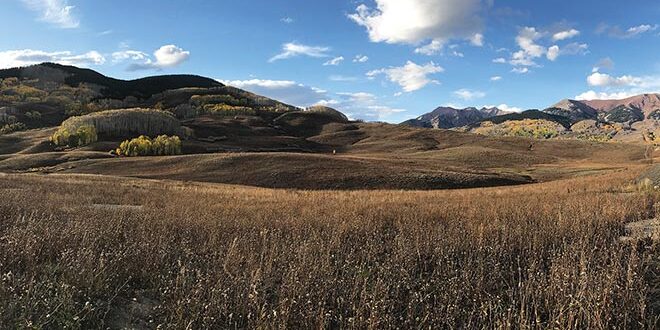“The proposal has significantly reduced the density of the project”
[ By Kendra Walker ]
On Thursday, August 4, the Mt. Crested Butte planning commission reviewed an updated planned unit development (PUD) proposal for the North Village. Now called the Village at Mt. Crested Butte, the proposal has been amended from the initial proposal seen earlier this year – with the biggest change including a decrease in the number of units from 700 now down to 342.
The 150-acre property adjacent to the base of Snodgrass is owned by Claudio Alvarez and his North Village Associates team has been working on the proposal over the past several years. From the beginning, the PUD application has aimed for a “flexible zoning” approach that will allow for publicly driven opportunities and stakeholders to establish themselves within the plan.
The proposal includes a new Rocky Mountain Biological Lab (RMBL) campus, a new visitor center, a year-round multimodal trail system, a new civic site with potential for town facilities, a potential boutique hotel and residential and mixed-use development.
The project will include up to 134,000 Gross Floor Area (GFA) of commercial use, up to 342 residential units, 40 dormitory bedroom units and up to 100 accommodation units (the previous iteration called for 400 hotel rooms). If a hotel is not built, the 100 accommodation units would revert to 40 residential units, for a total of 382 dwelling units.
A commuter trail will parallel the main boulevard and connect the Village to the Rec Path. The development also includes seven bus stops that will be completed in Phase I of the project.
Mt. Crested Butte deputy community development director Hillary Seminick wrote in a staff report, “The proposal has significantly reduced the density of the project throughout the process, and the compact, central development pattern will reduce sprawl up on the hillside, reducing the overall visual impact of the project.”
Another amendment to the proposal shows space reserved for potential public/civic space. “With leadership changes of town hall and the subsequent meetings with the applicant, the conversation around the potential of civic use or a town hall is back on the table for consideration,” said Seminick. “So, the applicant has designated this tract (10) for public or civic use, and the town has first right of refusal for this particular lot.” She explained that if the town were to decline, the tract would revert to 21 residential units.
North Village Associates has proposed constructing 40 dormitory units in lieu of the 17 units that would be required to meet the town’s community housing guidelines, and individual tract development will generate different employee housing needs depending on the number of residential units and commercial floor area. Should the Village realize full buildout, a total of 88.37 community housing units would be generated by the development. Alvarez has expressed the desire to explore public-private partnerships to provide community housing in excess of what is required by the Town Code.
The PUD application has been split into 15 different tracts/parcels that all have designated use. A master developer will construct the following improvements in Phase 1: a Boulevard Road, the Village Loop, a RMBL spur, a commuter trail, adjacent sidewalks, stormwater drainage facilities, horizontal bus stops, and water, sanitary sewer, and electric infrastructure. Development on each individual tract will be the responsibility of the tract developer. Density and floor area maximums have been established for each tract and the development of each individual tract will be required to receive design review approval from the town prior to development.
Tract 1 is for the visitor’s center, transit and one-two residential units.
Tracts 3, 4, 7 and 8 are residential, with no commercial use or short-term rentals (STR) allowed.
Tract 5 is intended for public use and transit, to support transit uses on Tract 1 and provide additional recreation amenities and parking.
Tract 6 is designated for the RMBL campus with 40 dormitory bedroom units and STRs are permitted.
Tract 10 is intended for public and civic use, however, should the town decline to develop the parcel, the tract will revert to residential use.
Tracts 11, 14 and 15 are designated for mixed residential and commercial use where STRs are permitted. Tract 15 is intended for a boutique hotel, however, if not developed it will revert to residential.
Tract 16 is for medium density residential where STRs are permitted but no commercial use.
A significant portion of the development will be preserved as open space, including three tracts totaling 64.59 acres. Tract 17-19 are open space tracts that could contain recreational trails, public recreation facilities, ski lifts, tows, agricultural use, nurseries and gardens.
The main Boulevard Road and trails network are the only areas proposed within a wetland or wetland buffer. The proposal includes a wetland mitigation plan in partnership with RMBL, including restoration from any disturbances, structural crossings for all wetlands and restoration of an erosional gully and headcut stream currently on the property.
The proposal also significantly reduces the number of units from the figures used to estimate Mt. Crested Butte Water and Sanitation District’s water availability. “It can be assumed that since the projections are based on a much greater number of units, that MCBWSD will be able to serve the development,” read the staff report.
Parcel F, a Mt. Crested Butte-owned parcel, is also located within the PUD. The applicant is not requesting amendments to the existing entitlements for Parcel F, but has requested a land trade to accommodate the proposed site plan in exchange for increasing the existing Parcel F frontage along Gothic Road.
Overall, the planning commission responded positively to the changes and the general proposal, and voted to continue reviewing the plan at the next available planning commission meeting.
 The Crested Butte News Serving the Gunnison Valley since 1999
The Crested Butte News Serving the Gunnison Valley since 1999


